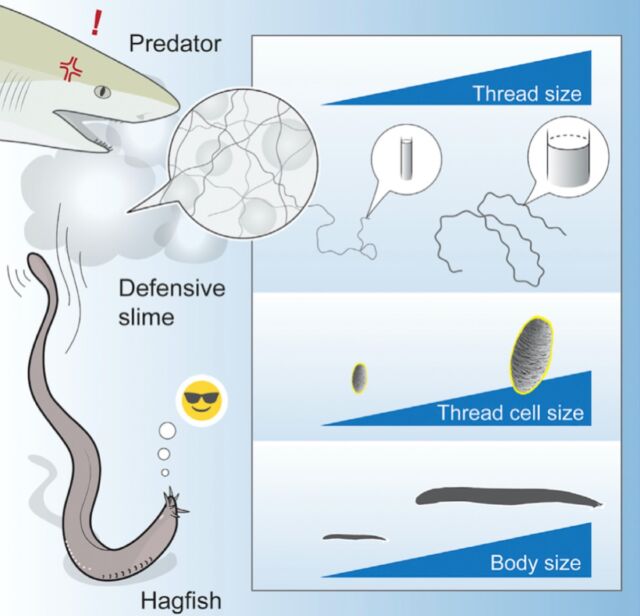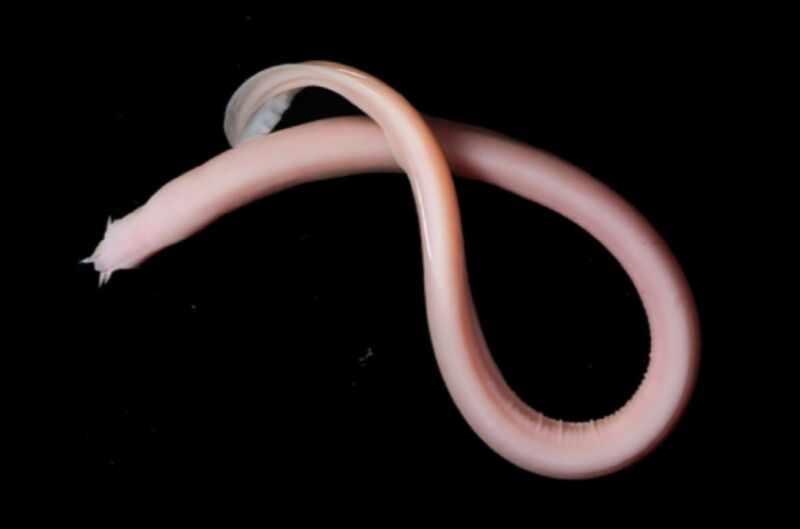Meet the humble hagfish, an ugly, gray, eel-like creature affectionately known as a "snot snake" because of its unique defense mechanism. The hagfish can unleash a full liter of sticky slime from pores located all over its body in less than one second. That's sufficient to, say, clog the gills of a predatory shark, suffocating the would-be predator. A new paper published in the journal Current Biology reports that the slime produced by larger hagfish contains much larger cells than slime produced by smaller hagfish—an unusual example of cell size scaling with body size in nature.
As we've reported previously, scientists have been studying hagfish slime for years because it's such an unusual material. It's not like mucus, which dries out and hardens over time. Hagfish slime stays slimy, giving it the consistency of half-solidified gelatin. That's due to long, thread-like fibers in the slime, in addition to the proteins and sugars that make up mucin, the other major component. Those fibers coil up into "skeins" that resemble balls of yarn. When the hagfish lets loose with a shot of slime, the skeins uncoil and combine with the salt water, blowing up more than 10,000 times its original size.
From a materials standpoint, hagfish slime is fascinating stuff. In 2016, a group of Swiss researchers studied the unusual fluid properties of hagfish slime, specifically focusing on how those properties provided two distinct advantages: helping the animal defend itself from predators and tying itself in knots to escape from its own slime. They found that different types of fluid flow affect the overall viscosity of the slime. A flowing liquid is essentially a series of layers sliding past one another. The faster one layer slides over another, the more resistance there is, and the slower the sliding, the less resistance there is. As I wrote for Gizmodo at the time:
Hagfish slime is an example of a non-Newtonian fluid, in which the viscosity changes in response to an applied strain or shearing force. ... Applying a strain or shearing force will increase viscosity—in the case of ketchup, pudding, gravy, or that classic mix of water and corn starch called “oobleck”—or decrease it, like non-drip paint that brushes on easily but becomes more viscous once it’s on the wall.
Hagfish slime can be both. It turns out that the suction feeding employed by many of the hagfish’s predators creates a unidirectional flow. The elongated stress of that sucking flow increases the goo’s viscosity, the better to suffocate said predators by clogging of the gills. But when the hagfish is trying to escape from its own slime, its motion creates a shear-thinning flow that actually reduces the viscosity of the slime, making it easier to escape. In fact, the slimy network quickly collapses in the face of a shear-thinning flow.
Scientists are still learning about the precise mechanism by which the hagfish produces the slimy stuff. Prior work has shown that sea water is essential to the formation of the slime and that hagfish skeins can unravel spontaneously if ions in the seawater mix the adhesives that hold the fibrous threads together in skeins. But the timescales matter, too. A 2014 study, for instance, showed that any spontaneous unraveling of the skeins would take several minutes—yet the hagfish deploys its slime in about 0.4 seconds.
A 2019 paper in the Journal of the Royal Society Interface suggested that turbulent water flow (specifically, the drag such turbulence produces) is an essential factor. The movement of the surrounding water as a predator attacks helps trigger the uncoiling. Skeins have a loose end; tugging on it triggers the unraveling. But drag from flowing water as a predator thrashes about makes this process happen even faster.
This new paper summarizes findings from the latest research by Douglas Fudge, a marine biologist at Chapman University who has been studying the hagfish and the properties of its slime for years. For instance, way back in 2012, when he was at the University of Guelph, Fudge's lab successfully harvested hagfish slime, dissolved it in liquid, and then “spun” it into a strong-yet-stretchy thread, much like spinning silk. It's possible such threads could replace the petroleum-based fibers currently used in safety helmets or Kevlar vests, among other potential applications.
For this latest paper, Fudge et al. took samples from 19 different species of hagfish (both large and small), took microscopic images, and carefully measured the size and shape of the thread cells in those images. The resulting database incorporated measurements from more than 11,700 cells harvested from 87 hagfish (the latter measuring between 10 and 80 cm in length).

They found that those thread cells were extremely large in comparison with similar cells in vertebrates—larger than the abdominal fat cells in elephants, in fact. Even more intriguing, the size of those cells turns out to be heavily dependent on the body size of the hagfish. There are other examples in nature of this kind of scaling.
For instance, geckos and other creatures that use adhesive pads for climbing show a scaling exponent of about 0.35 with regard to the size of their pads compared to body mass. And certain species of spider produce dragline silk whose diameter scales with body mass with an exponent of between 0.37 and 0.39. But the scaling exponent Fudge et al. found in their hagfish thread cells was 0.55, significantly larger than any other known scaling exponent in vertebrates.
“Our work showed the largest known scaling exponent in animal cells," said co-author Yu Zeng. “We analyzed the size of hagfish gland thread cells—which make silk-like threads that reinforce hagfish slime—and found that they increase with body size. This means, on the evolution tree of hagfishes, the large species all make large thread cells, despite the fact that they are distantly related.”
The authors hypothesize that the unusual feature might be the result of evolutionary selection related to the mechanical properties of the thread cells. “Very little is known about hagfish behavioral ecology, especially how it changes with body size," said Yu. "Our study suggests that body size-dependent interactions with predators have driven profound changes in the defensive slime of hagfishes, and these changes can be seen at the cellular and sub-cellular level."
The team's models showed that the threads become thicker and longer in the larger cells of larger hagfish, which can produce threads some 4 micrometers thick and 20 centimeters long. This is the largest known intracellular fiber in animals, comparable in size to keratin fibers and spider silks. And like those examples, the threads in hagfish slime rely on coordination among numerous cells. At some point in their growth cycle, the intracellular protein fibers in hagfish slime "undergo a phase transition," per the authors, "where individual [fibers] condense with their neighbors into a much larger intracellular fiber superstructure."
So what is it about this scaling feature—and resulting larger threads—that could provide an evolutionary advantage? "There are several ways in which larger threads may be useful for larger hagfishes” said Fudge. “Thicker threads can withstand more force before they break and make the slime stronger and better able to remain on the gills of a large and powerful fish predator. Longer threads have a similar benefit in that they can span across larger distances between the gill arches of large predators.” Longer threads are also more likely to produce greater volumes of slime, enhancing its use as a defensive deterrent against larger predators.
Future studies will focus on investigating just how each thread packs such a complex structure into a tiny cell, according to Yu.
DOI: Current Biology, 2021. 10.1016/j.cub.2021.08.066 (About DOIs).



3175x175(CURRENT).thumb.jpg.b05acc060982b36f5891ba728e6d953c.jpg)

Recommended Comments
There are no comments to display.
Join the conversation
You can post now and register later. If you have an account, sign in now to post with your account.
Note: Your post will require moderator approval before it will be visible.